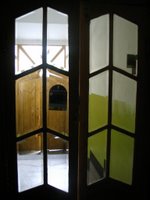Into cubism
I was alone. It was 6 o'clock in the morning. I had to leave.
The streetcars in Prague were returning from the Old City to Vysehrad and the outskirts beyond it. They edged along narrow tracks and though they did not move fast you could not get a good look inside them. Walking beside them, I wondered if there were commuters on their way into work. Were they sitting or were they standing? The windows seemed to catch a glare and hold it. It didn't matter what angle keen peering eyes had. It was as good as all the tourists in the city gazing into the Charles River, which flowed behind the cars. Perceiving anything past the surface was impossible.
 Very soon, I would have to board one to get to the airport.
Very soon, I would have to board one to get to the airport.But not immediately. I walked on. Josef Chochol's buildings were not far along this line. They often faced the traffic. You couldn't miss his houses, even though at first I wasn't sure if had already passed others like them on the street leading to Libusina 3.
 Libusina 3 was guarded and had entrances on two streets. It was not far from the intersection that Neklanova 30 presided over. Silent, steely and boastful, I was surprised to find that the dwelling at Neklanova 30 was unlocked and I slipped inside.
Libusina 3 was guarded and had entrances on two streets. It was not far from the intersection that Neklanova 30 presided over. Silent, steely and boastful, I was surprised to find that the dwelling at Neklanova 30 was unlocked and I slipped inside.
Josef Chochol finished this apartment house in 1914. Interiors echoed the outside. The hall was completely empty and quiet. Flat features like ceilings and glass doors had geometric relief. Every surface wanted to be a corner, a joist, any point at which two planes could meet. I opened an the inner door on the vestibule. I hoped the sound I was making did not carry. I crept up a darkened staircase.

There was no elevator. I debated how many floors I should go up. The third was no more interesting than the second. Maybe the fourth would reward me. Occasional small windows offered some dim light so I could determine that each landing had a few units. Not the slightest movement - was this building vacant? For my own sake, I hoped the apartment doors I eased past were thick. It was now only 6:30. Not knowing much convincing Czech, how could I explain myself on the fifth floor, sputtering camera in hand? One last photo and I wouldn't have to give it another thought. The batteries had gotten so low that my flash was not working. I noticed the lights overhead and wished they were turned on. I saw the switch on the wall and hit it. A buzzer rang. It was loud and long. Much longer than I had held it. Much longer than time I stood stunned, remarking at the strange distance between a Czech apartment buzzer and its door. It lasted even longer than I could hear it resounding down the staircase but my pounding feet on each descending cubist step kept me from knowing that for sure.
 *Cubist architecture is inspired from the paintings of Picasso and Braque. Their basic idea was to convey three dimensions when their canvases only had two by not adhering to a single perspective. Cubist theory is not particularly germane to architecture, but Joseph Chochol, among others, were taken with cubism's unique geometry as well as the reduction and fragmentation of planes ... Worldwide, the Czech Republic is the only home to cubist houses.
*Cubist architecture is inspired from the paintings of Picasso and Braque. Their basic idea was to convey three dimensions when their canvases only had two by not adhering to a single perspective. Cubist theory is not particularly germane to architecture, but Joseph Chochol, among others, were taken with cubism's unique geometry as well as the reduction and fragmentation of planes ... Worldwide, the Czech Republic is the only home to cubist houses.


0 Comments:
Post a Comment
<< Home